- Lifestyle & Sports
- 09 Jan 25

Athlone Town and Galway United have been shaking up the Women’s League of Ireland, challenging the historic dominance of Dublin clubs with trophy-winning teams, solid fan-bases, volunteer commitment and strong marketing. Paul O’Mahony reports on an eventful 2024 season as women’s soccer continues to make headway in this country.
The stranglehold that the traditional powerhouses of women’s football in Ireland – Shelbourne, Peamount United and Wexford – have had since the top league’s inception has been smashed. And not before time. All hail Athlone Town and Galway United, the ‘new kids on the block’...
“We knew if we beat Bohemians in our last home league game we were champions,” says the manager who engineered Athlone’s success, Ciaran Kilduff. “It was a great moment for us. We needed our full squad to bring Champions League football to Athlone next season. We’d won the FAI Cup the previous season, but to win the league with a game to spare spoke volumes for the group, and the work that went in all around the club.”
Both Galway United and Shelbourne have been left with a feeling of ‘what might have been’. Galway set the pace for much of the season and finished in third; Shelbourne, who improved dramatically as the season progressed, were second.
“When we reflect on it,” admits Galway United manager, the delightfully named, Phil Trill, “there’s a feeling that we left it behind us. Some of the players feel that. We had never been in the position where we were ahead and other teams were chasing us. We hadn’t had that experience. I think back to the Wexford game in June. We were one-nil up in the 89th minute and conceded two late goals.
“It’s probably a game we had to lose on our journey, like losing one one-nil to Bohemians early on. We couldn’t break them down. Experience of those situations is going to help. We beat the eventual league winners, Athlone Town, home and away, and beat them well.”
Advertisement
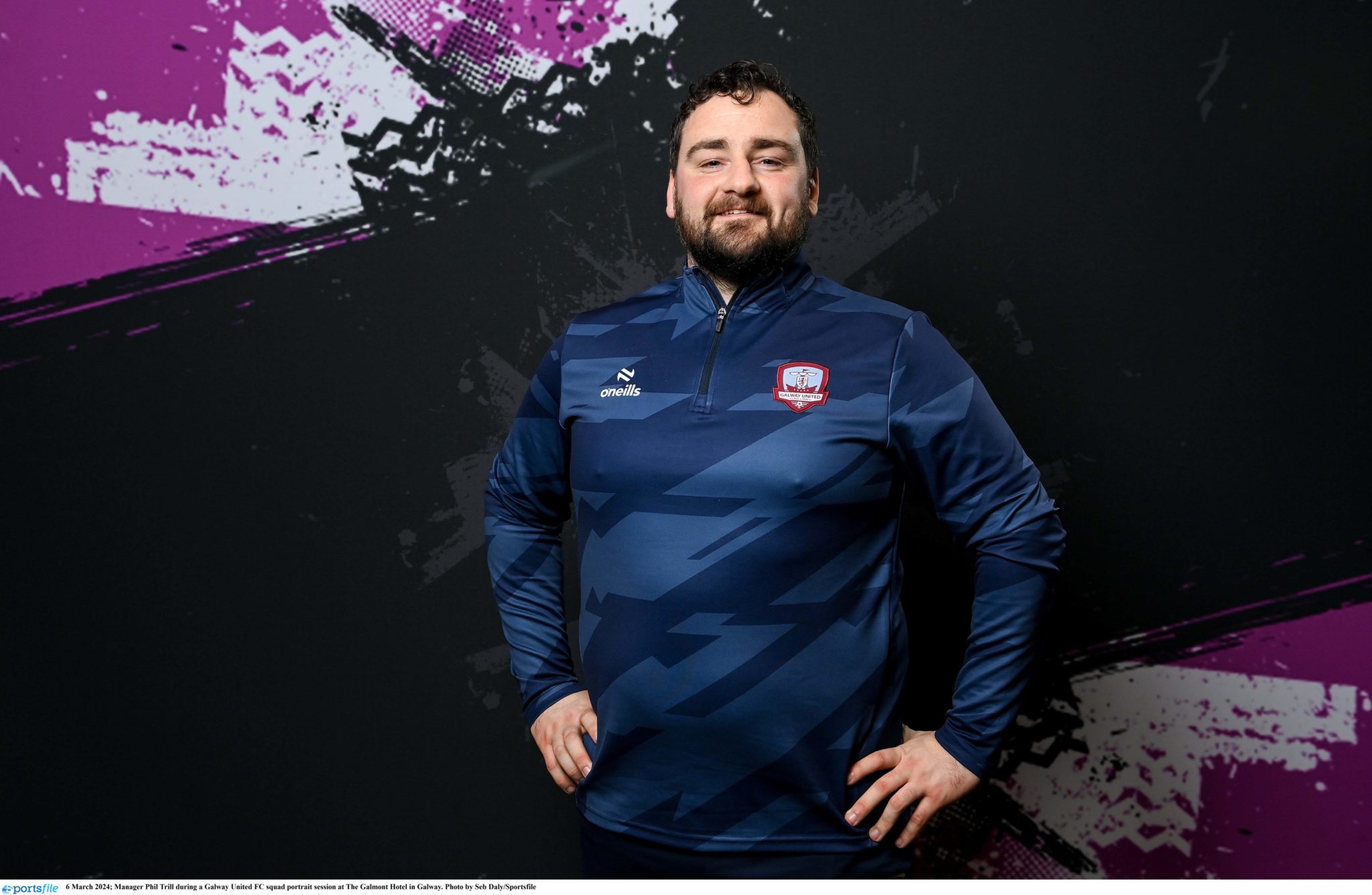
Manager Phil Trill - Galway United FC. Photo by Seb Daly/Sportsfile
Shelbourne captain and centre half, Pearl Slattery, is left with similar feelings.
“I’m very proud, losing just one league game (to Athlone) all season,” she says. “We had a really good goal difference, a lot of clean sheets. We were really high quality for a lot of it. People may look back at the Athlone game and the Bohemians game in the second half of the season as to why we didn’t win the league. But I think it goes back further, to the Sligo Rovers and Wexford draws.
“We always seemed to be chasing a leader, whereas we historically like to get ahead and stay there. No excuses, though, we had loads of shots in those two draws and probably should have won the games. I’ve been around long enough, and sometimes you get the feeling that it’s meant to be your year. Not this year.
“Athlone had injuries, but still picked up the key points in the second half of the season. That was incredible. You just have to acknowledge it was their year. There was that feeling when they won the FAI Cup Final last year as well, when we should have closed it out but didn’t.”
REAL BREAKTHROUGH
Advertisement
For both Slattery and Trill, the rise of Athlone and Galway consolidates a big breakthrough. Athlone have now won four trophies (League, FAI Cup, two President’s Cups) in two years, while Galway have won two All-Ireland Cups.
“Beyond my Shels involvement, you want the league to be attractive and competitive, and to inspire young girls around the country,” explains Slattery, who also works with the FAI. “Some of the games we’ve had with Galway over there have been my most enjoyable. I remember our league game, live on TV. It was incredible, a great atmosphere.
“Luckily, we won the game, but it was a great occasion. Galway have some great players, as have Athlone, but the games against Treaty United (of Limerick) were some of our toughest this year. You want four or five teams challenging for the title. A few years ago, it wasn’t like that. It was Shels and Peamount and maybe Wexford.
“If you lost to one of them, the league was nearly gone because nobody else was going to take points. Now it’s different: the league is in a really good place, I think.”
Phil Trill agrees.
“It’s great for the women’s game,” he says. “We had some players in our academy that now play for Athlone, and it’s brilliant to see them do well.”
Trill dismisses the idea that the Dublin teams have become complacent, allowing their midlands and western competitors to dine at the top table.
Advertisement
“I don’t think Shelbourne were being complacent. They came strong again this season,” he says. “Plus, I think it’ll just be a matter of time before Shamrock Rovers come good, given the money they’re putting in.”
“Shels are a very experienced team, so we knew there was no room for error,” says Kilduff. “I think we won 15 of 19 games leading into our last game, but Shels won 13, so draws let them down. We lost the opening game of the season and took only four points of a possible nine, which didn’t look like title-winning form.
“But we kept picking up points and winning when we didn’t play well. Wetook four points from Shels. The win in Tolka Park was a big result. We knew what we had to do. The fixture schedule was demanding. We had Sligo Rovers in the semi-final of the FAI Cup on Sunday, then Wexford in the league on Wednesday and Shamrock Rovers on the Saturday.
“We won all of those – but we were nearly on our last legs, as we’d used a lot of the same players. That set up the title-winning game against Bohs in Athlone. We had a lot of respect for Shelbourne, but we knew from way out that the league was in our hands.”
That respect for Shels proved justified. Eight days after the final round of league games, Shels and Athlone squared up for the third time in three years in the FAI Cup Final. They had won one each prior to what transpired to be a sensational, history-making day, with Shels hammering Athlone 6-1. They might have lost the league title, but they made sure Athlone weren’t going to do the double.
“After winning the league, to have the hunger can be difficult,” says Pearl Slattery. “Almost everything we created in the first half of the final was going in. But that’s football. We had countless shots on goal in those league draws against Sligo and Wexford, but couldn’t score. But we did in the cup final.”
Advertisement
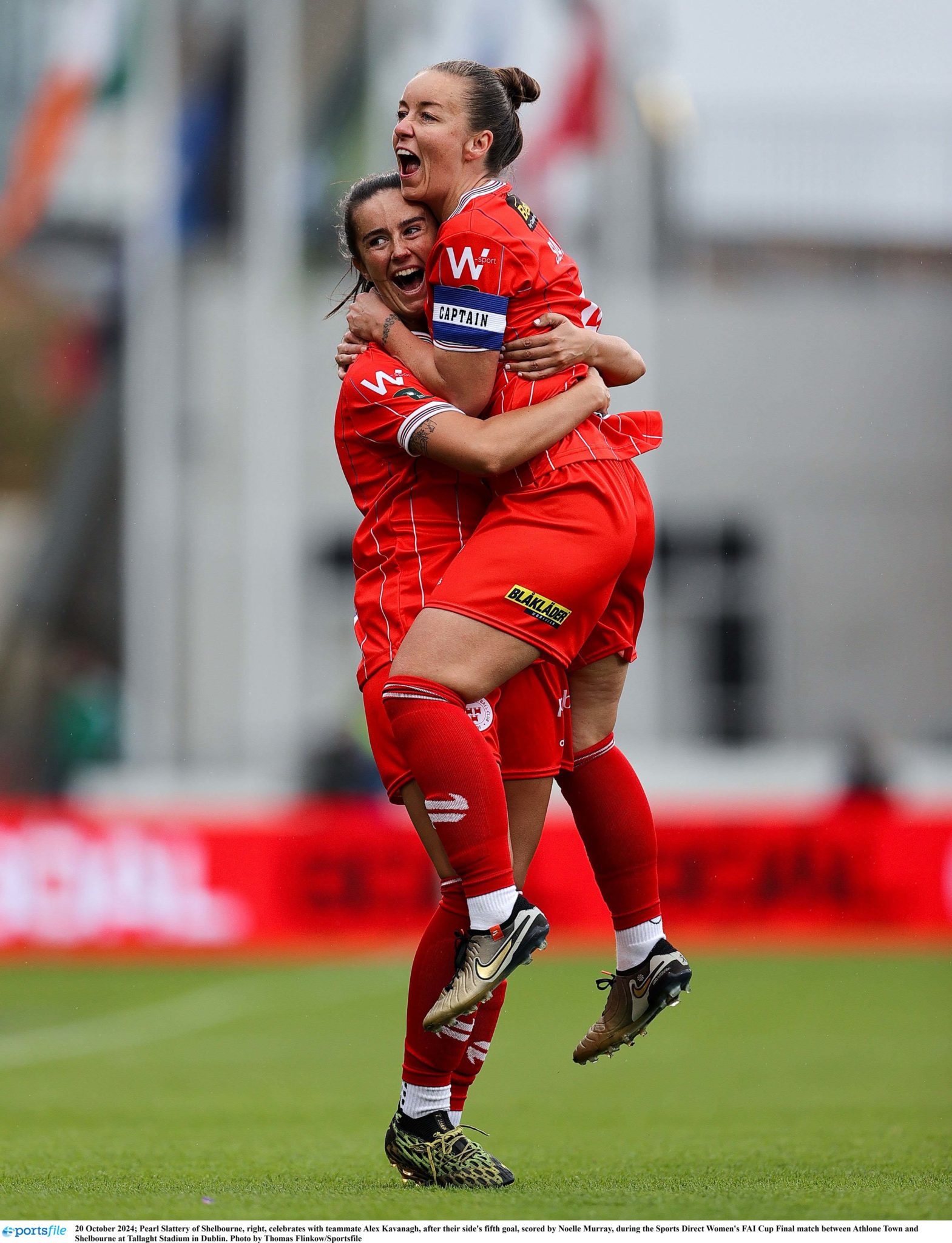
Pearl Slattery of Shelbourne, right, celebrates with teammate Alex Kavanagh, after their side's fifth goal, scored by Noelle Murray, during the Sports Direct Women's FAI Cup Final match. Photo by Thomas Flinkow/Sportsfile
“It was probably a game too far,” concedes Kilduff of their 6-1 defeat. “We’d been flagging for a few weeks and just focusing on seeing the results out. We just ran into a brilliant team on cup final day – they had six shots on target in the first half and scored all six! They blew us away but, in fairness, we were a tired group by then.”
What’s it like standing on the touchline as a manager, and watching six goals go past your team in the first half of a cup final?!
“I knew there was no point in lambasting them at half time,” he says. “They’d given everything all season. We had a young team too. I think nine of my team were 22 or younger, whereas Shels had a very experienced team that day.
“No one wanted the score to get any worse – they had pride. They played better in the second half. I learned a lot about them in that second half. It was a tough day, but I had got everything out of that team during the season. I was so proud of them.”
MID-SEASON MASTERSTROKE
While players like Madie Gibson, captain Laurie Ryan, Chloe Singleton and Roisin Molloy were key in building towards their 2024 title success, the addition of Cameroon international striker and formidable physical presence, Brenda Tabe, was a mid-season masterstroke by Kilduff and Athlone.
Advertisement
“Brenda was someone the club had targeted in the off season,” he notes. “Coming from Cameroon, there were issues around visas and so on, so we’d been waiting for a while. To be honest, she arrived at just the right time because Casey Howe (striker) was off to England and we needed someone coming in.
“We’ve some great young players, like Hazel Donegan, waiting in the wings as well. They’ll get opportunities, but Brenda hit the ground running. She had some really creative players like Madie Gibson, Roisin Molloy and Isabel Ryan as a supply line, so Brenda was loving it. She was thrown in at the deep end and responded to that very well. She’s a real character in the dressing room as well! She’s very respectful of her team and her club and her captain. She’s very popular.”
Shelbourne’s feeling of ‘what might have been’ was symbolised by the successful acquisition – also mid-season – of striker Kate Mooney, a poacher with the ability to ghost into the box at the right time. She finished the season as the top scorer across both league and FAI Cup, notching up 12 goals.
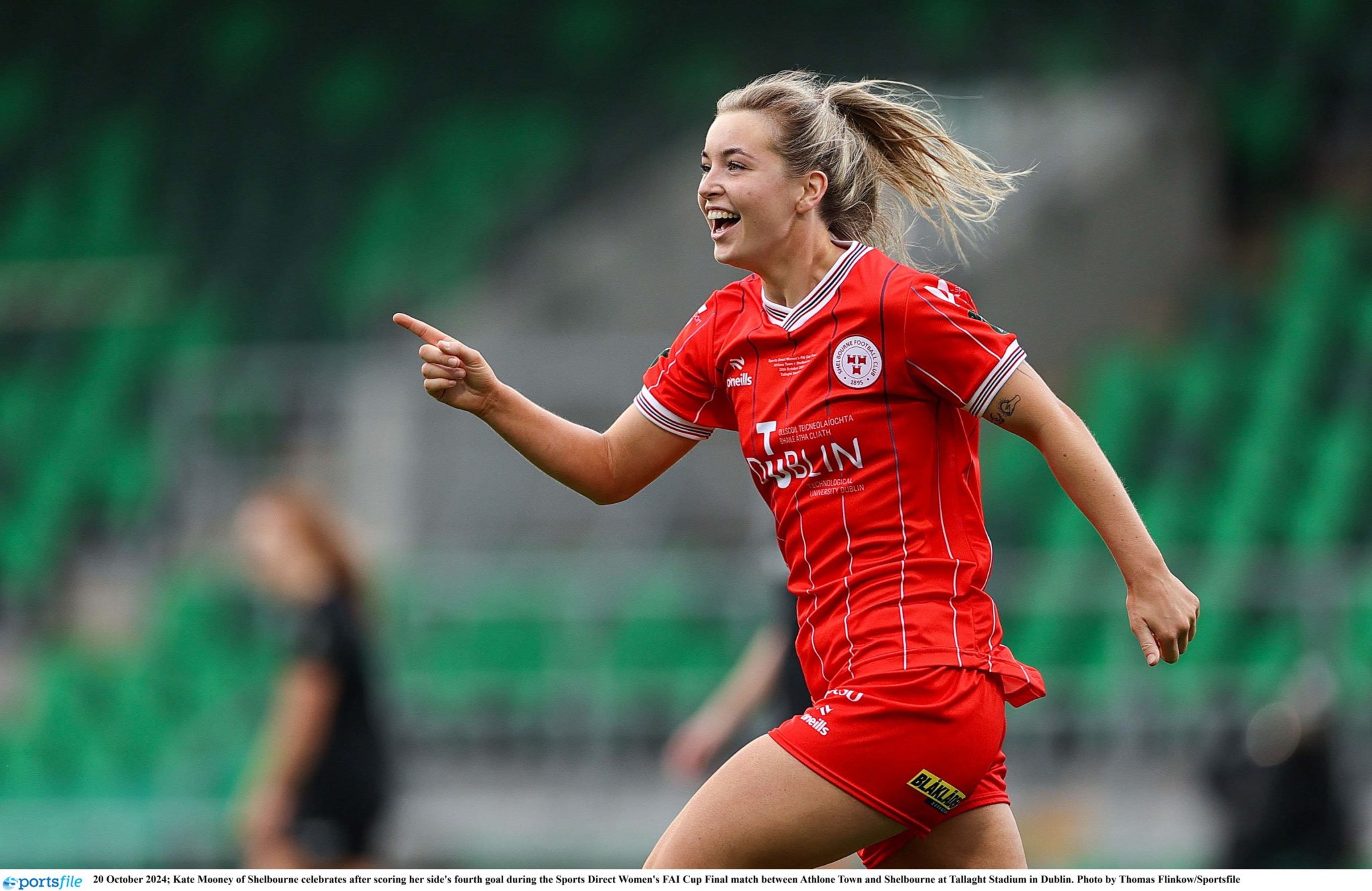
Kate Mooney of Shelbourne. Photo by Thomas Flinkow/Sportsfile
“If we had been able to get Kate at the start of the season, we could have won the league,” Pearl Slattery says. “No disrespect to our other players, but she gets you different types of goals. Sometimes, we almost try to score perfect goals, but Kate gets you everything. She’s a nightmare for defences.
“Cup final days are so special. We had a new manager this season (Eoin Wearen) and new players who hadn’t experienced it. Each one is a unique experience. I love the build- up, the day itself, all your family there. We were hurt from losing last year to Athlone on penalties. We really wanted to do it this time.”
Advertisement
The consistently brilliant Alex Kavanagh put an early marker down by ‘welcoming’ Madie Gibson to the game with a strong tackle. She then worked sensational short triangles with colleagues Roma Mclaughlin and Noelle Murray.
Mooney bagged the opener, pouncing on a first defensive hesitation from Athlone and rounding goalkeeper Katie Keane before applying a deft finish. From there, the floodgates opened and Shels were six up, before Tabe replied for Athlone. The game was all but over by half time.
FORMIDABLE COMPETITOR
That defeat notwithstanding, Athlone are a fine football team. They’re also a tough, physical side who can give and take it – much like Kilduff himself, who was a formidable competitor in his League of Ireland days. Champions always need steel as well as style.
“I agree,” he says. “The first thing you have to do in football is win the battle, then the football comes out. If a team out-fights you, they’ll beat you. Statistically, I think we had the best disciplinary record in the league. We don’t go over the edge, but we look after ourselves. The battle starts long before the whistle. You need to have that steel, to deal with adversity and pressure.
“Even in the 2023 cup final against Shels, we were losing with four minutes to go and we dug it out to bring it to penalties. You have to have that. This season’s cup final against Shels was our third against them and that wasn’t a fluke. Athlone is a club that pushes its women’s team. It’s been a pleasure working with them.”
Advertisement
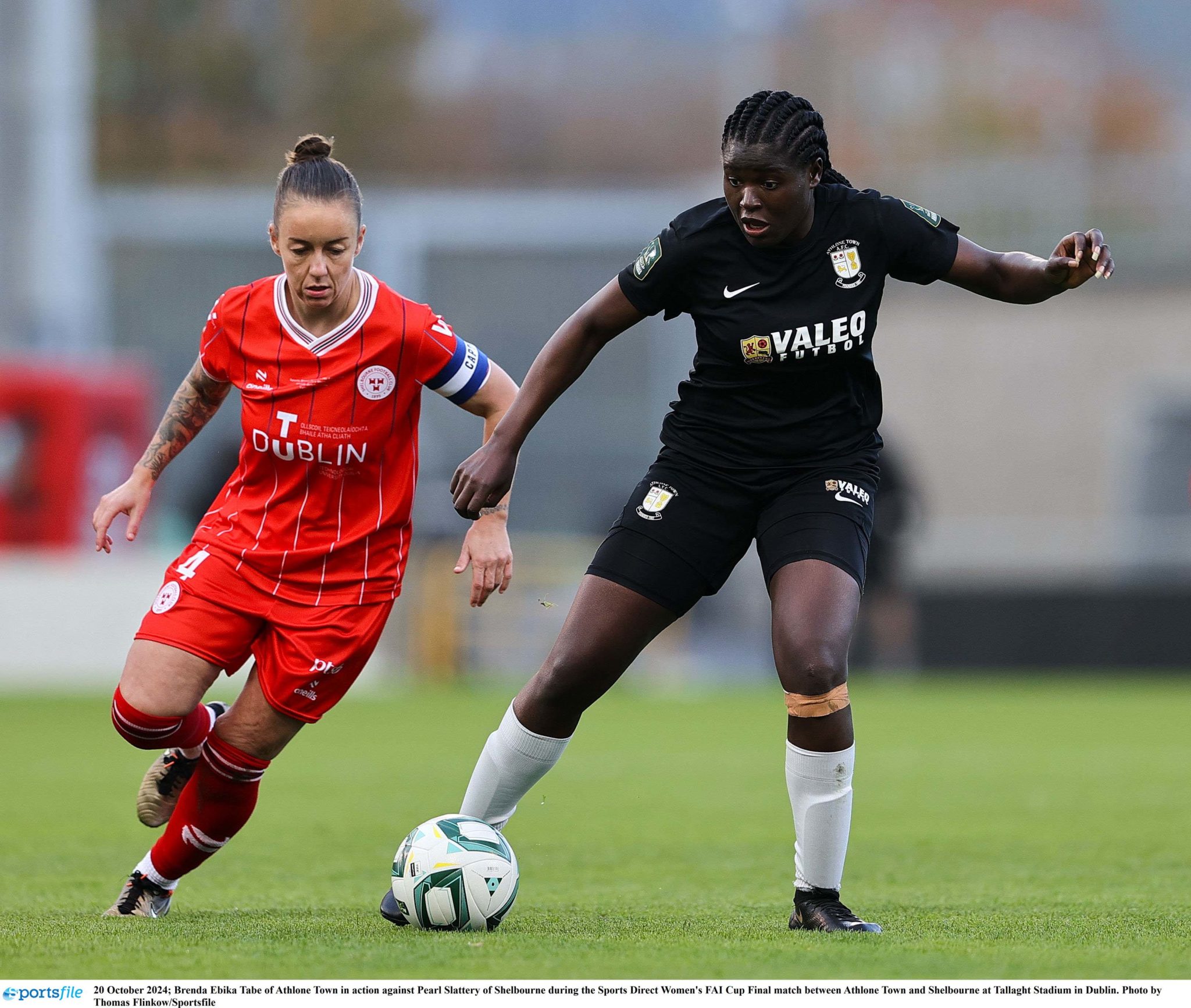
Brenda Ebika Tabe of Athlone Town in action against Pearl Slattery of Shelbourne. Photo by Thomas Flinkow/Sportsfile
For Galway United, the season brought success, too, with a second successive All-Ireland Cup, a competition wherein League of Ireland teams challenge some of the top Northern Ireland women’s teams.
“We’ve made a lot of progress and maybe have a bit to go,” says Phil Trill. “Our plan is to be sustainable, on and off the pitch. What we’ve achieved so far is remarkable. Even winning the All-Ireland Cup for the past two seasons – I think people will look back and say, ‘Do you remember that team?”
It is only recently that Galway transitioned from being an independent club, Galway Women’s FC, to becoming part of the longstanding League of Ireland club, Galway United. They made headlines in the last match of the 2021 season, when they unexpectedly hammered title favourites Peamount after going 2-0 behind, handing Shelbourne with the opportunity to snatch the title, which they duly did. The likes of former Hot Press blogger Emma Starr, Lynsey McKey and Julie-Ann Russell were key to Galway’s role in what was an unforgettable night in women’s League of Ireland history.
“I was fortunate in that, at the time I was appointed under the new Galway United set up, we had a bit of a blank slate,” explains Trill. “The United board were very good in the sense that they were asking us, ‘What needs to happen?’ They were excellent in backing and supporting that. There were some difficult decisions, too, as Galway WFC had a full squad and some people needed to move on in order for us to kick-start our vision for the new entity.
“When I got the job, I didn’t sleep at all that night. I had to go into work [as a teacher] the next day with a heavy head. It took me a day or two to get my head around it, that we were going to be able to do what we had dreamt about for a while. Then we started putting the wheels in motion.”
RATTLING IN GOALS
Advertisement
Young Galway players like Jenna Slattery and Kate Thompson have been rattling in goals. There has been excellent club marketing and promotion, especially via social media, community promotion, and schools participation. All of this culminated in Galway United women’s side attracting a Women’s League of Ireland record crowd of 2,861 to Eamon Deacy Park for their match against DLR Waves in May 2024. They had a four-points lead over Shelbourne at the time.
Their average gate sits at around 500. The Galway United men’s team were doing really well also, following promotion. As a result, there’s been a real buzz about the City of the Tribes that is the envy of Cork City and some Dublin clubs alike.
“I’m really happy to be involved,” says Trill. “We need to be realistic, though. It’s just over ten years since Galway United came back from the ashes. But full credit to the board and the people who kept it alive. Now maybe their vision is coming to reality, when you see the women breaking attendance records and the men packing Eamon Deacy Park.”
Was Ireland’s involvement in the Women’s World Cup a factor?
“The World Cup was good,” he adds, “but I think there was a lot of false promises about it, in terms of bringing more investment. Clubs copped on to that and put a bit more effort in themselves this year.”
Athlone’s Drive-in Bingo initiative on Thursdays and Sundays reflects the work put in by so many to assist clubs with fundraising and social interaction.
For Shelbourne, it was great to see Christie Gray (Canada) and Maggie Pierce (USA) win FAI Cup medals – following in the footsteps of the legend that is Emma Starr (USA), who arrived at Shelbourne mid-season in 2022 and won a double.
Advertisement
“I’m more happy for the girls when we win stuff than for myself,” Pearl Slattery smiles. “And when we lose, I feel bad for them. Last year, Christie and Maggie won nothing. You can have whatever facilities and so on, but there’s a core group of girls in Shels who play for the crest, and those two have ‘got it’. They’ve given everything for the club since they’ve been here. Their attitude has been spot on. I’m delighted for them and the whole group.”
"I'M ARGUING FOR THE BETTERMENT OF THE LEAGUE"
While the Girls In Green have enjoyed several landmark moments in recent years, some believe that there is an increasing disconnect between the national side and the domestic league. Ciaran Kilduff, Pearl Slattery and Phil Trill tease out the issue.
A consistent gripe about the women’s League of Ireland in season 2024 was the disrupted fixture schedule, with the league interrupted regularly by All-Island Cup fixtures, Ireland’s Nations League matches, FAI Cup fixtures and the mid-season break.
“It was frustrating,” says Ciaran Kilduff. “Ironically, when I took the job in summer 2023, there was a six-week mid-season break for the World Cup. That gave me a good opportunity to have time with the squad, because I was changing the style of play, changing the shape, bringing in new players. So, I had a pre-season in mid-season! This season, if you got a bad result, you could be left stewing on it for three weeks, where you’d prefer to be heading straight to the next match.”
As a player, Pearl Slattery knows that feeling.
“We were so frustrated as a group of players, it was so stop-start,” she says. “The Northern Ireland teams in the All-Island Cup have the fixtures in their pre-season period. I hope the FAI will be looking at where it is in our season calendar, so it doesn’t interrupt the league fixtures.”
Advertisement
In an end of season bombshell. the day after the FAI Cup Final, Ciaran Kilduff announced that he was leaving Athlone. The players must have been heartbroken. When Madie Gibson scored a fabulous long-distance free kick against Shamrock Rovers in September, it said something about Kilduff that she and the team all ran to him and his coaching team on the touchline to celebrate the moment.
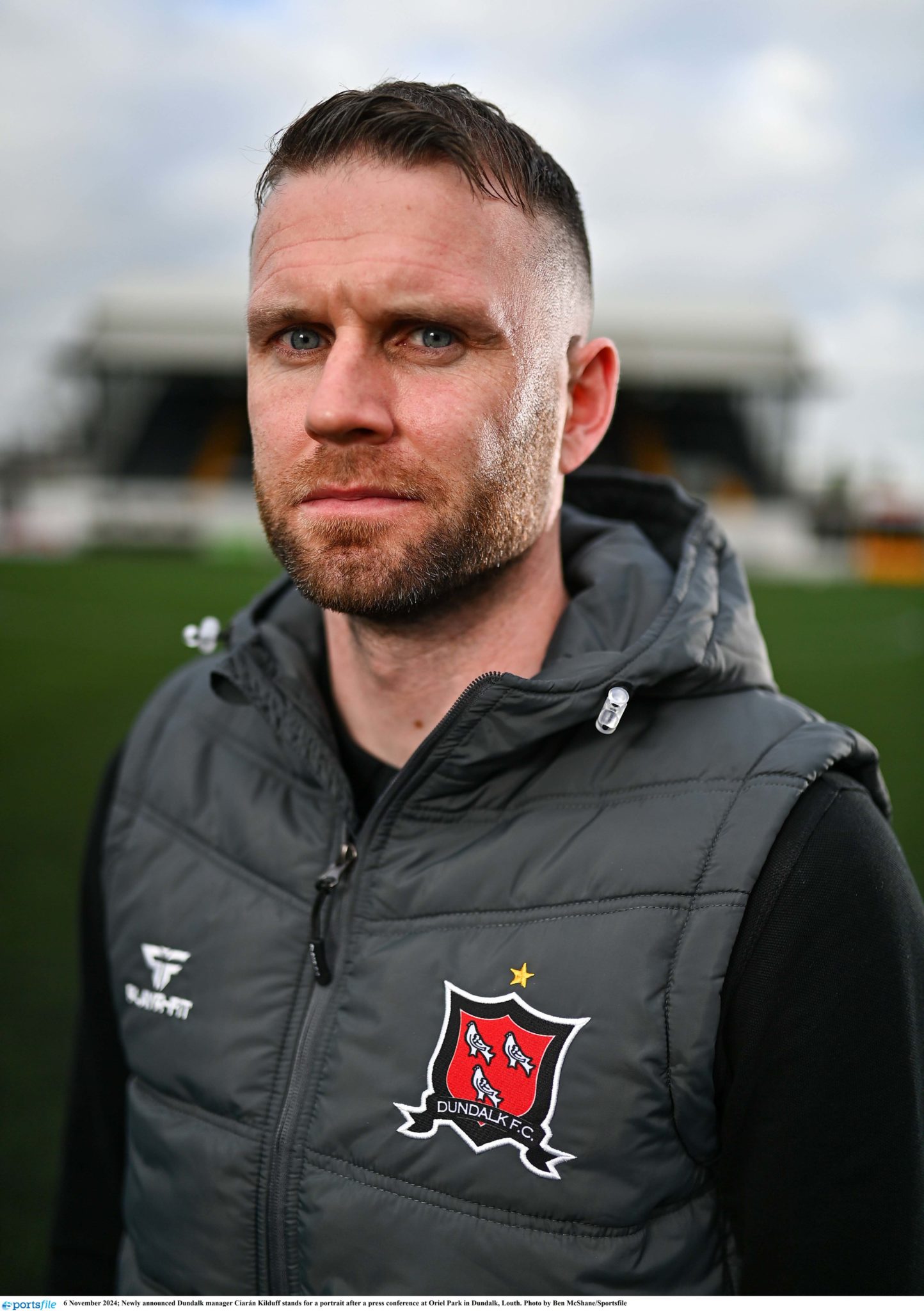
Ciarán Kilduff of Dundalk FC. Photo by Ben McShane/Sportsfile
For his part, Kilduff next heads to troubled Dundalk in the men’s League of Ireland.
“I just knew myself that my time was up with Athlone,” he reveals. “It takes a toll. There was a good deal of travel involved, and I needed a new challenge. I’m still a young man, with a young family. I still talk to a lot of the girls regularly, they’re a special group and we achieved so much together. We have memories for life. Everyone of them congratulated me on my new role at Dundalk, and I’ll be following their fortunes, too.”
Kilduff, however, didn’t sign off without making his feelings publicly known about what he called the “disconnect” between the women’s League of Ireland and the women’s national team.
“I stand over everything I said, and no one has re-educated me on it,” he explains. ”I know I’m right. I’m arguing for the betterment of the league. I mean, I had players in Athlone who were playing for Northern Ireland, like Casey Howe. She could’ve played for the Republic of Ireland. Now, she’s over in Nottingham Forest and viewed as a star over there, banging in goals and getting Player of the Match in the UEFA Nations League for Northern Ireland.
Advertisement
“What did disappoint me about the episode was people within the league, even senior players, coming out and saying, ’This didn’t work, that didn’t work’. It’s not about the senior players, it’s about the young players – there’s a whole cohort from about ages 19 to 23 who are missing out. My argument wasn’t with one particular person. My argument was that we need to help our league here.”
SPOTLIGHT ON THE LEAGUE
He’s on a roll now.
“It wasn’t about Ciaran Kilduff against Eileen Gleeson, either,” he says. “What I was looking for was a structure, something to show how we get to the international level. Almost the entire national squad have all played in our national league, including Katie McCabe. So I was saying we need to look after what we have here. I can guarantee you that, in 10 years’ time, 95% of our national team will be made up of players playing in our league now.
“If you look at the achievements of our U19s in the Euros in the summer, 90% of that team are playing in our league. Many will progress to the senior national team. They’re all here, they’re all domestic players. I believe that point needs to be continually reiterated and fought for, because there are so many great players, characters, hard working people, in and involved with the women’s league – yourself included – who are trying to put a spotlight on this league. I think an U23s national team would help. That’s my hope.”
Kilduff doesn’t agree with those who say there should be a quota or percentage of players from the women’s League of Ireland in the Ireland national squad.
“I think you have to pick the best available team,” he explains. “Earlier in the season, I was quite vocal about the fact that our team was not being looked at. And there was no longer a home-based squad [as there was under previous national team manager, Vera Pauw], no under 21s and no under 23s.
Advertisement
“What was being created was a scenario – like with the men’s international team – where you had to go abroad in order to play for Ireland – you couldn’t be playing here. So, with the women’s team now, they eventually did what everyone was thinking and included Galway’s Julie-Ann Russell and when she got in, she started rattling in goals. I remember a high-profile broadcast media person and one of the first questions he asked her was: ‘So, I suppose you’ll be going abroad again?’ The implication of the question was that you can’t be playing that well and staying in the League of Ireland.
“I’m not blaming anyone in particular for this. I think it’s a cultural thing in the governing body that our league isn’t good enough, but the league across the water is. That doesn’t have to be the case.”
As if to underline his point, the recent selection of the supremely talented 20-year-old Ellen Molloy in the national team came just weeks after she made a move from Wexford to Sheffield United. What kind of message is that sending to our league players and coaches?
“The narrative may change eventually, because if they continue to be behind the times, the clubs will move past them,” says Phil Trill. “What was the knock-on effect of the Women’s World Cup? We didn’t get any insight, any data reports. It was just let’s ride the wave and see where it goes.
“You mentioned Alex Kavanagh, Ellen Molloy and others. Our Jenna Slattery is, in my view, the most in-form player in the whole country. All the metrics are there. We’re probably an outlier, as we now have Julie-Ann Russell getting picked by Ireland.”
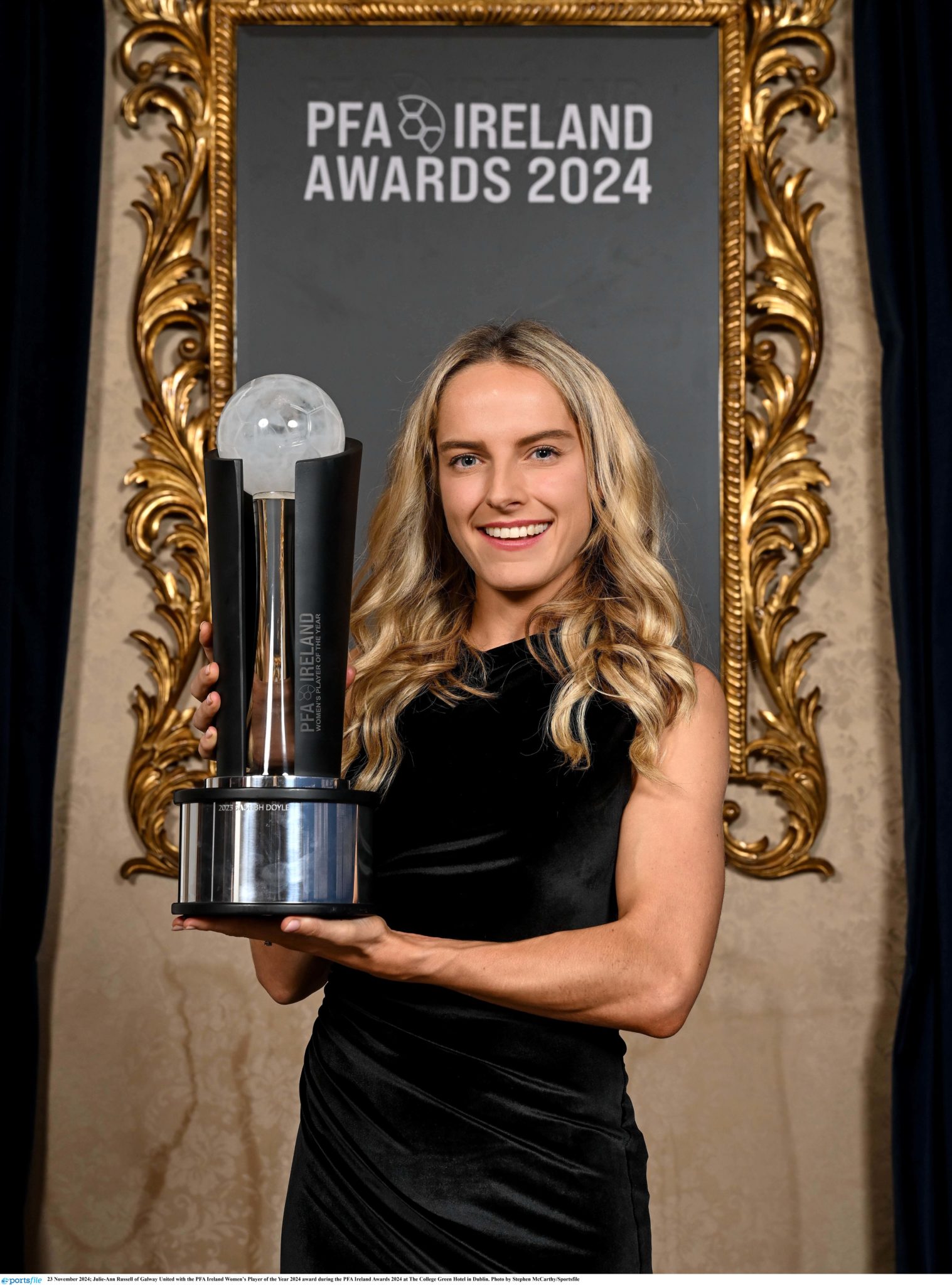
Julie-Ann Russell of Galway United with the PFA Ireland Women’s Player of the Year 2024 award during the PFA Ireland Awards 2024. Photo by Stephen McCarthy/Sportsfile
Advertisement
The astonishing, disrespectful abandonment of the home-based squad – a League of Ireland ‘Best of’, who trained regularly, overseen by Vera Pauw and national team coaches like Tom Elmes – was like a kick in the teeth.
Kilduff picks it up.
“Even if the home-based squad was only a placebo-type concept, players at least felt like they were being seen,” he says. “We’ve had players interested in Gaelic football and other sports. So if they can’t see a path to progress, they might go, ‘Ah, sure, it doesn’t matter what I do, but I might get to play in Croke Park if I go the GAA route’. I realised very quickly as a manager that I needed a carrot like that. Unlike the men’s LOI, only one women’s team in the league can qualify for Europe and, really, that’s not enough.”
ATTENDANCE RECORD
Phil Trill also has issues around this.
“You mentioned the home-based squad,” he says. “Therese Kinnevey has been one of Ireland’s biggest talents for a long, long time, and is still an exceptional player. She was part of that home-based squad – and that was it. No conversation, silence, and she’s definitely a player good enough to play international football.
“My job as manager here is to support the players, protect them, and back them. It would have been great to have some representation from the international staff when we broke the attendance record for a women’s league game here, and they were notified in advance.”
Advertisement
They didn’t show. For Ciaran Kilduff, his next challenge is in the men’s game. He’ll have ‘noisy neighbours’ now, with Drogheda United staying up in the top league and also winning the men’s FAI Cup.
“That’s the beauty of football. Drogheda need Dundalk and Dundalk need Drogheda, that’s the nature of rivalry,” he says. “I had friends who won the cup with Drogheda and I was delighted to see them win a medal, and then win the play-off. It gives encouragement to a lot of the teams in the league.”
For the Women’s League of Ireland, the departures of Athlone’s Kilduff and Peamount’s James O’Callaghan are big losses.
“I’ve great respect for Ciaran,” Trill says, “and we always had good conversations. I wish him all the best. It’s never nice to see players leaving our league; it’s not nice to see managers like Ciaran and Peamount’s James O’Callaghan leaving our league. James has been a great source of light and life in women’s football.
“I was at an awards event in 2019 with the U17s and James said to me, ‘Ye’re (Galway) coming, aren’t ye? Coming like a train.’ He’s a class act, and someone I really admire. Three league titles with Peamount and talent continuing to come through. Maybe he doesn’t get the credit he deserves, but I looked up to him when I came into the women’s league.”
With women’s League of Ireland managerial changes also underway at Treaty United, Cork City, Sligo Rovers, Bohemians and Wexford, and with Waterford due to enter the women’s top league next season, 2025 is already an exciting prospect. Maybe Galway United and Shelbourne won’t be the only two challengers for Athlone’s title.
And so it should be.










